Urartu Religion › Urartu Art › Teishebaini » Origins and History
Articles and Definitions › Contents
- Urartu Religion › Origins
- Urartu Art › Origins
- Teishebaini › Origins
Ancient civilizations › Historical places, and their characters
Urartu Religion › Origins
Definition and Origins
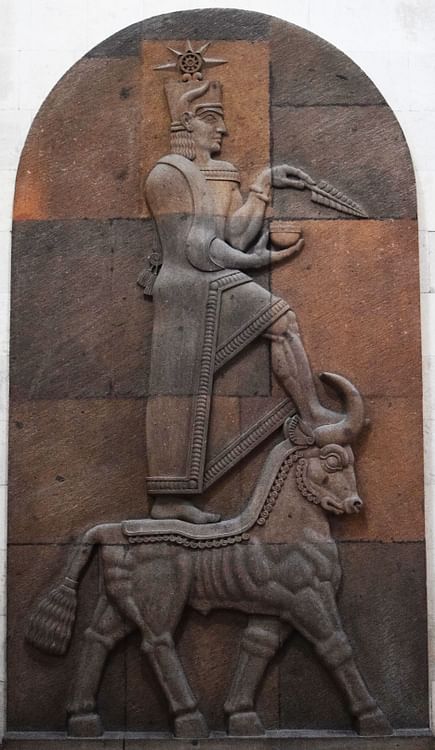
The religion of the Urartu civilization, which flourished principally in ancient Armenia from the 9th to 6th century BCE, was a unique mix of indigenous, Hurrian and Mesopotamian gods and symbolism. The pantheon was headed by the trinity of Haldi, Teisheba, and Shivini, who were the principal beneficiaries of sacrifices and temples built in their honour. Inscriptions, dedications and representations in art are all a testimony to the importance of religion in Urartu culture and especially to warfare.
THE URARTU PANTHEON
The gods of the Urartu religion were many, but they are handily listed in a 9th-century BCE inscription discovered in a niche in the mountains near the capital Tushpa (Van). The list, inscribed in duplicate, mentions 79 gods and the various sacrifices which should be made to each. The large number of deities may be explained by the fact that the Urartu religion adopted gods and practices from the Hurrians and other Mesopotamian cultures, which were mixed with indigenous Urartian gods. In addition, a feature of Urartu territorial expansion was the assimilation of local gods into the official pantheon of the conquerors. Many of these local gods were totems and represented such important elements or prominent natural features as water, earth, the sun, mountains, caves and trees. Still other deities were related to ancient animalistic beliefs.
ALL WARS WERE CARRIED OUT IN HALDI'S NAME, HIS BLESSING WAS SOUGHT BEFORE A CAMPAIGN & HE WAS GIVEN A REPORT OF IT AFTERWARDS.
The three most important Urartu gods were Haldi (Khaldi), god of war and the supreme deity, Teisheba, the god of storms and thunder who was likely based on the Hurrian god Teshub, and Shivini, the Sun god, who was often represented as a kneeling man holding a winged solar disk, and therefore likely inspired by the Egyptian god of the same association, Ra. Haldi’s consort was Arubani (or Bagmashtu in the eastern part of Urartu, notably at Musasir/Ardini), the most important female goddess; Teisheba’s consort was Huba (aka Khuba), and Shivini’s was Tushpuea (aka Tushpues). The close cultural relations between Urartu and Assyria are again illustrated by the Urartian application of the Assyrian ideograms for the gods Adad and Shamsh to their own gods Teisheba and Shivani respectively.
Other important gods include Sielardi, the moon goddess, Epaninaue, the land goddess, Dsvininaue, a sea or water goddess, Babaninaue, the goddess of mountains, and Sardi, the star goddess. Most towns were given their own local god or goddess who was often named after the settlement, e.g. “the god of the town of Kumanu”. The most famous examples of such naming conventions were the capital Tushpa named after Tushpuea and the important city of Teishebaini, founded and named after Teisheba by king Rusa II (r. c. 685-645 BCE).
HALDI
Haldi had always been an important deity but it was the mid-9th century BCE king Ishpuini who promoted Haldi to the head of the gods. A deity of foreign origin, like the supreme god in many other ancient cultures, his role and function are obscure. We do know that he was closely associated with warfare and all wars were carried out in his name, his blessing was sought before a campaign, and he was given a report of it afterwards. Haldi also has more inscriptions dedicated to him than any other god. So important was this god that the Urartians were sometimes called the Haldians or “children of Haldi”. The ruling king was known as the “servant of Haldi” and many inscriptions end with the phrase “By the will of Haldi” (Haldini ishmasini).

Bas Relief of Haldi
Haldi had temples specifically built in his honour which have distinctive square towers with reinforced corners. As might be expected for the god of war, his temples were adorned with dedications in the form of weapons: swords, spears, bows and arrows, as wells as armour, helmets, and shields. Indeed, sometimes a temple of Haldi’s is referred to as the “house of weapons”. One Assyrian inscription from the reign of Sargon II (722-705 BCE), who sacked Ardini in 714 BCE, lists in detail the mass of weaponry dedicated and stored at Haldi’s temple there:
25,212 bronze shields, 1514 bronze javelins…and 305,412 swords… One large sword, a weapon worn at his waist…of gold; 96 silver javelins…silver bows and silver spears, inlaid with gold and mounted; 12 heavy shields… 33 silver chariots. (quoted in Chahin, 140)
In addition, even during peacetime Haldi remained prominent in the minds of the Urartians, and all public works such as roads, canals and palaces were built in his name.
RELIGIOUS ARCHITECTURE
Temples were constructed, as already noted, and, although none survive, some of their details may be gleaned from external sources such as contemporary Assyrian reliefs. One such relief is from the palace of the Assyrian king Sargon II which shows the temple of Haldi at Ardini before it was sacked in 714 BCE. The building stands on a high platform and has a hexastyle portico (six-columned facade) and triangular pediment. The pitched roof carries a spear ornament, and shields hang from the exterior walls. A great urn stands either side of the entrance. Not only temples but fortresses, too, were associated with particular gods, for example, two fortresses around Lake Sevan were known as “the fortress of the god Haldi” and “the fortress of the god Teisheba”.
TEMPLES, WITH THEIR OWN AGRICULTURAL LANDS, WERE AN IMPORTANT ELEMENT OF THE COMMUNITY AND THE ECONOMY.
Temples, with their own agricultural lands, were an important element of the community and the economy. They were also a method to impose cultural as well as political dominance over subject peoples. As already mentioned, some foreign gods were imported into the Urartu pantheon but conversely, and especially in the less advanced northern territories which were regarded as “barbaric” compared to eastern cultures, the Urartian kings did impose their own gods. Rusa II, for example, built a temple to the storm god Teisheba in the newly conquered Sevan area.
OFFERINGS, SACRIFICES & BURIALS
Ceremonies and rituals to honour the gods were held in dedicated outdoor ritual spaces with low surrounding walls, the temples described above, and at false doorways carved into rock faces which were known as “Gates to the Gods”. Animals were sacrificed to honour the gods, typically bulls, cows, goats, and sheep. Other offerings included food, weapons, and precious goods, as well as libations of wine.
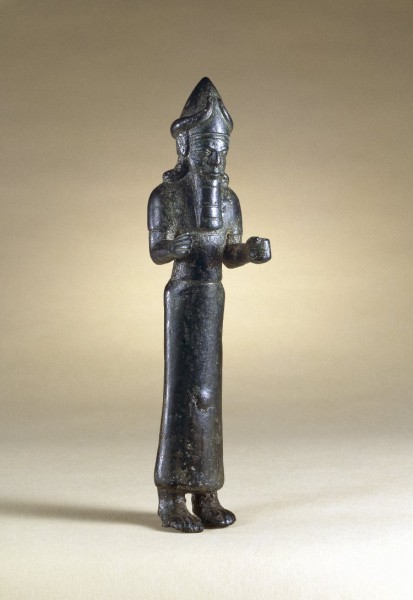
Urartean Male God Figurine
The Urartu royalty and elite were buried in tombs, usually cut into rock promontories. At the capital Tushpa, there is a royal necropolis composed of chambers cut into the mountain on which the city was built. Similar examples can be found at fortress sites. Tombs are composed of single, double, or triple chambers with the tomb entrance sealed by a large stone slab. Several royal tombs, long since looted, still carry inscriptions which describe the deeds and campaigns of the ruler in question. Of those tombs discovered intact, several contain stone sarcophagi with semicircular lids. Buried with the deceased were precious goods, weapons, shields, and even furniture, a practice which suggests the Urartians believed in an afterlife and that it was similar enough to the earthly one to necessitate such provisions.
RELIGIOUS ART
Religious art includes bronze figurines of prominent gods such as Haldi, Teisheba, and Shivini. Haldi is often portrayed as a man, with or without a beard, standing on a lion, symbolic of his courage, power, and virility. In contrast, Teisheba is shown standing on a bull and holding thunderbolts in his hands. Some figurines of deities are unidentified such as a female goddess rendered in bone, and there are, too, strange hybrid figures of a fish-man, bird-man, and scorpion-man. These latter creatures, frequently painted on storeroom interior walls, were likely regarded as protective spirits. Large bronze cauldrons were produced in significant numbers, and their rims are often decorated with the heads of winged female goddesses, perhaps representations of Tushpuea. Processions of gods are sometimes depicted in the wall paintings too. Finally, as perhaps is to be expected for a war god, Haldi is frequently represented on engraved weapons, belts, shields, and medallions.
This article was made possible with generous support from the National Association for Armenian Studies and Researchand the Knights of Vartan Fund for Armenian Studies.
Urartu Art › Origins
Definition and Origins
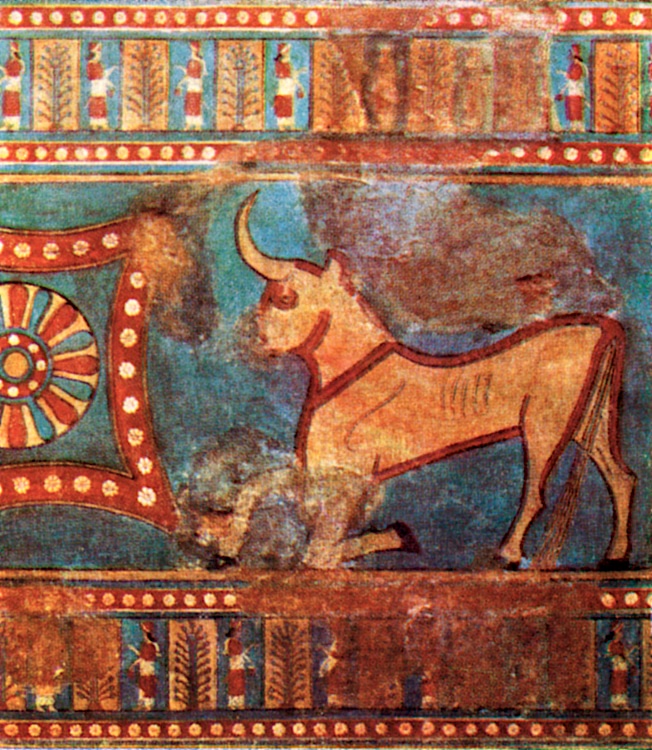
The art produced by the Urartu civilization, which flourished in ancient Armenia, eastern Turkey, and northwestern Iran from the 9th to 6th century BCE, is best seen in bronze figurines of deities, bronze cauldrons with animal and goddess head decorations, and vibrant wall paintings. A mix of Mesopotamian and indigenous subjects coupled with outstanding craft skills make the artworks of Urartu some of the star attractions in the Near Eastern collections of museums worldwide from London to Saint Petersburg.
IDEAS & INFLUENCES
Overshadowed by its more powerful neighbour Assyria (both in the past and today), without surviving examples of extended text of its own, and having had much of its precious material culture destroyed or looted, it can be difficult to disentangle the art of Urartu from that of the civilizations who were its predecessors, contemporaries, and even successors. One is on safer ground when examining the artefacts themselves in isolation rather than searching for their connection to each other and the art of other cultures. Certain points then become clear - the Urartians were master metalworkers, cauldrons especially being a forte. Wall painters were as accomplished as in any other culture, too. Such skills were acquired and developed over many decades, even centuries, and with such skills, one can presume there was also innovation both in technique and ideas. History shows that expert artists do not copy for very long before they begin to experiment.
The Urartu civilization was only rediscovered in the 19th century CE, and it has a lot of catching up to do with its more famous contemporary cultures, but ongoing excavations are steadily building up a clearer picture of the capabilities, inspirations, and legacy of one of the region’s most important Bronze and Iron Age cultures. It is clear that Urartian art was particularly influenced by contemporary Assyrian and Near Eastern art and that produced by the earlier cultures of the Hittites and Hurrians. Such subjects as lions, bulls, mythological creatures (e.g. griffins and centaurs), horse riders, and military themes provide a strong link between all of these cultures. Finally, Egyptian art was not unknown either, and artefacts with hieroglyphs, notably faience bowls and statuettes, have been found at Urartian sites.
EXTENSIVE EXCAVATIONS SUCH AS THOSE AT TEISHEBAINIHAVE REVEALED THE WIDE RANGE OF MATERIALS, MEDIA & SUBJECTS IN URARTIAN ART.
A consequence of these cultural connections, coupled with the lack of identifying inscriptions in many cases, is that some artworks can be difficult to positively identify as made by artists from Urartu, Assyria or the Achaemenid Empire. An added difficulty is that many surviving Urartian artworks come from Assyrian sites where they were either taken as loot or which were produced specifically for that market by Urartian craftsmen. These works, though, may well have been produced during a period of political and artistic decline when Urartian art had lost some of its uniqueness. Thankfully, extensive excavations, such as those at Teishebaini (Karmir-Blur), have revealed the wide range of materials, media and subjects typical of Urartian art.
MATERIALS & MEDIA
Metalworking has a long history in the region, dating back to the 10th millennium BCE. Artisans in the Urartu kingdom had access to local mineral deposits which included gold, silver, copper, lead, iron, and tin. Other metals which the artisans and artists of Urartu could use included alloys such as bronze (copper and tin), brass (copper and zinc), and electrum (gold and silver). Artists also used wood, hardwood, stone, bone, stag horns, semi-precious stones (e.g. sardonyx, agate, and cornelian), enamel, faience, and ivory for their work. Common media for Urartian art includes figurines, engraved and inlaid weapons and armour, pottery, wall paintings, and highly decorative furniture.

Bas Relief of Teisheba
LARGE-SCALE SCULPTURE
Unfortunately, no large-scale sculpture survives except in fragments. The most important example is the six surviving pieces of a basalt relief statue of the storm god Teisheba. Dating to the 7th century BCE, the original figure stood on a bull facing a second figure with a triple spearhead between the two. It was excavated at Adilcevaz, north of Lake Van, and a full reconstruction has been made which can be seen in the Erebuni Historical and Archaeological Culture Preserve in Yerevan, Armenia.
The largest sculpture suggested by a surviving fragment is a life-size figure of a ruler. Only the torso of the figure has survived but the narrow beard and ends of long hair suggest a royal person. The left hand holds a bow and some arrows while the right hand holds either a club or whip. That such large figure statues were erected at Urartian temples is known through Assyrian inscriptions and artwork which describe and depict attacks on Urartu during the mid- to late-8th century BCE.
METALWORK
Metalworkers cut, cast, embossed, engraved, and inlaid metal to produce such ornate goods as jewellery of all kinds, helmets, shields, quivers, pectorals, small seals and amulets in the shape of bells, horse harness pieces, horse bits, belts, buckles, figurines, and candelabra. Bronze and copper seem to have been the materials of choice. Large bronze cauldrons were a speciality, often with three-dimensional animal or human heads around the rim and as handles. A magnificent bronze bull’s head handle ornamentation can today be seen in the British Museum in London.
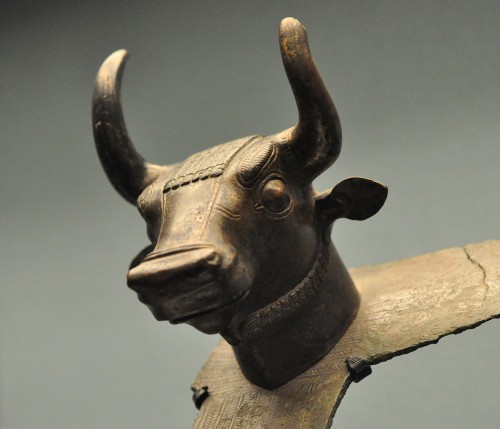
Bronze Bull Head from Urartu
Winged female goddesses are another common choice for cauldron decorations, and they perhaps represent the goddess Tushpuea, the consort of Shivini, the sun god. A splendid example is today in the Hermitage Museum in Saint Petersburg. The cauldrons, having rounded bottoms, were set on embossed bases or tripods. The type, in general, is very similar to Etruscancauldrons, which were likely inspired by the Urartu model, indeed, some examples may well be of Urartian manufacture.
Bronze plaques, placed in niches in interior walls, were etched with geometrical designs and scenes of horsemen and chariots, sometimes even buildings, too. Some plaques have gold and silver leaf decoration. Bronze belts were engraved with hunting scenes, for example, lion-hunts. Shields had large central bosses made in the form of mythical creatures, lions, and bulls. Shields may also show concentric bands of embossed lions and bulls as in the two examples now in the British Museum in London. Those bronze items such as the more ornate shields and weapons belonging to the royal household are so identified by inscriptions which have also helped to identify Urartian works found outside Asia.
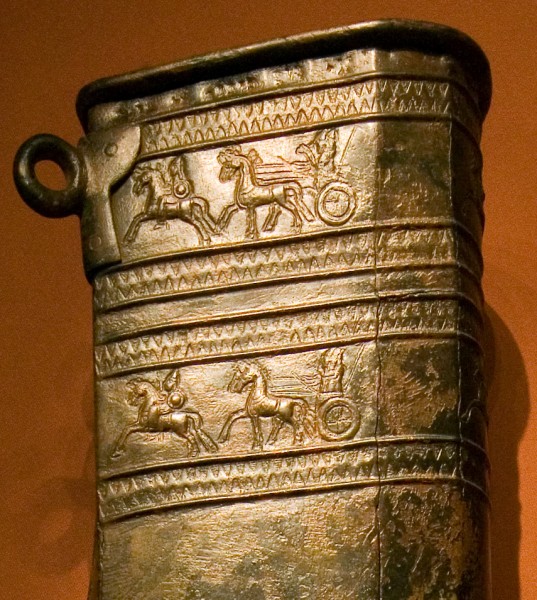
Urartu Decorated Quiver
WALL PAINTING & FLOORING
Excavations have revealed both public and private buildings in Urartian cities had interior wall paintings. The palace complex at the fortress site of Erebuni alone had over 2,000 square metres of wall paintings. Painted on plaster, surviving sections and fragments show scenes with animals, mythical creatures, processions of gods, and scenes from everyday life such as agriculture, cattle breeding, and hunting. The scenes are usually set within broad decorative borders made up of palmettes, geometric shapes or small repeated human figures. Backgrounds are usually white, outlines are drawn in black, and blue and red are the most commonly used colours.
Flooring was of stone in the more prestigious buildings with surviving examples having either large basalt slabs or even large-stone polychrome mosaics with geometric designs. Interior walls could have cavities cut into them into which were placed not only the decorative bronze plaques described above but also decorative cut stone slabs in red, white, or black.
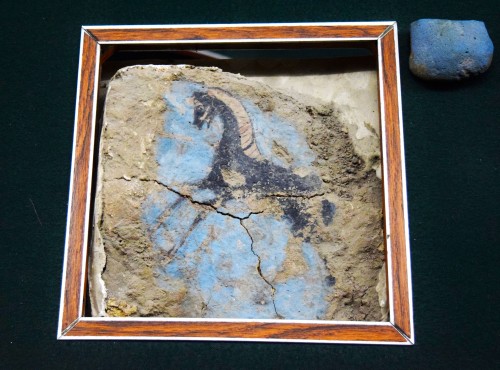
Urartian Horse Mural Fragment
FURNITURE
Furniture was placed in elite tombs, especially thrones and matching stools. Perhaps largely made of wood, they have not survived complete but fragments made from cast or solid metal, usually bronze or copper, do survive. These remnants are highly decorative and take the form of finely sculpted standing human figures or mythical creatures such as winged bulls with human heads or winged bird-lion hybrids which were intended to protect the person who sat on the throne. In some examples of these figures the face may have been rendered in gold or semi-precious stone and, consequently, this part has long-since been removed by looters. The recesses of many of these miniature sculptures contain traces of gold leaf suggesting that the whole was once covered in shining gold.
POTTERY
A wide range of vessels was made both for everyday and ceremonial use. The most common type has a polished red surface while a typical form is the one-handled jug. Large jars were made and then sunk into the floors of storage buildings in which were kept foodstuffs, especially grain, oil, and wine. The largest examples of these had a capacity to hold 750 litres (200 gallons). A label etched in cuneiform very often indicates the contents of storage vessels. One unusual form is the vessel made in the shape of a boot, complete with painted stitching and laces. Several examples have been excavated from the fortress city of Teishebaini and date to the 8th century BCE. Finally, pyxides (small lidded boxes) were produced and decorated with relief or painted scenes of religious and everyday life. There are several surviving examples of these in stone, too.
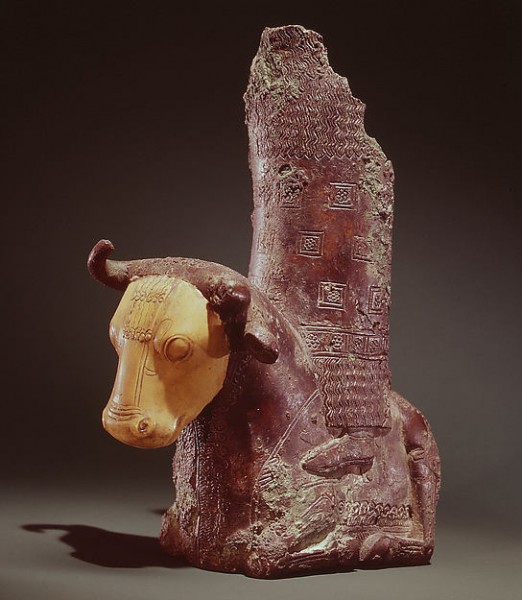
Urartu Deity & Bull
RELIGIOUS ART
Religious art includes bronze figurines of prominent gods such as Haldi, Teisheba, and Shivini. Haldi, the head deity and god of war, is often portrayed as a man with or without a beard standing on a lion, symbolic of his power, courage, and virility. In contrast, Teisheba, the storm god, is shown standing on a bull and holding thunderbolts in his hands. Shivini, the sun god, was often represented as a kneeling man holding a winged solar disk, and was, therefore, likely inspired by the Egyptian god of the same association, Ra.
Some figurines of deities are unidentified, such as a female goddess rendered in bone, and there are, too, strange hybrid figurines of a fish-man, bird-man, and scorpion-man. These latter creatures, frequently painted on storeroom interior walls, were likely regarded as protective spirits. The Tree of Life, another motif from Mesopotamian art, appears in various media, typically with a figure standing either side of it and making offerings.
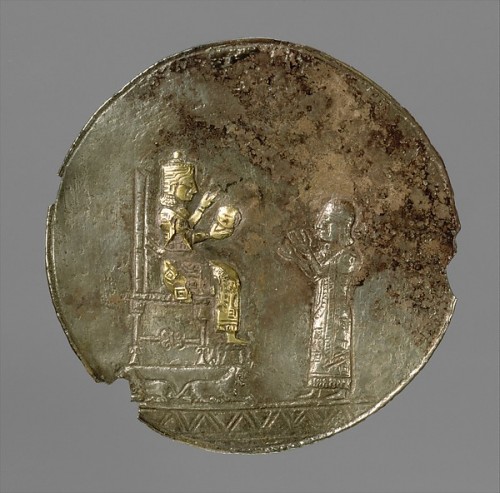
Urartu God & Worshipper
Weapons were made using precious materials which were not for military use but destined as offerings at temples to the gods. Assyrian inscriptions describe temples in Urartu containing silver bows and arrows, gold swords, silver javelins and spears, and even silver chariots. Finally, as perhaps is to be expected for a war god, Haldi is frequently represented on engraved weapons, belts, shields, and medallions.
LEGACY
As already mentioned, there is a striking resemblance in many features of the art and objects produced in Urartu and other cultures in the Near East but also further afield in Archaic Greece, especially on Crete, Rhodes , Samos, Delphi, Corinth, and elsewhere. Etruscan art shows similarities too. Whether these ideas arose independently or were transferred via traders, the exchange of objects or by the movement of artists themselves is a moot question. The point of contact between these various Mediterranean cultures would most likely have been the thriving port of Poseidon (Al Mina) at the mouth of the Orontes River in southeast Turkey, which was controlled by Urartu in the first half of the 8th century BCE.
Some motifs seen in the art of Urartu continued to appear in the art of the region into much later times, just as the Urartian language continued long after the cities had been taken over by the Medes and successive powers. The Tree of Life motif, for example, was still being used in the folk songs and illustrated manuscripts produced in Armenia during the medieval period.
[naasr]
Teishebaini › Origins
Definition and Origins
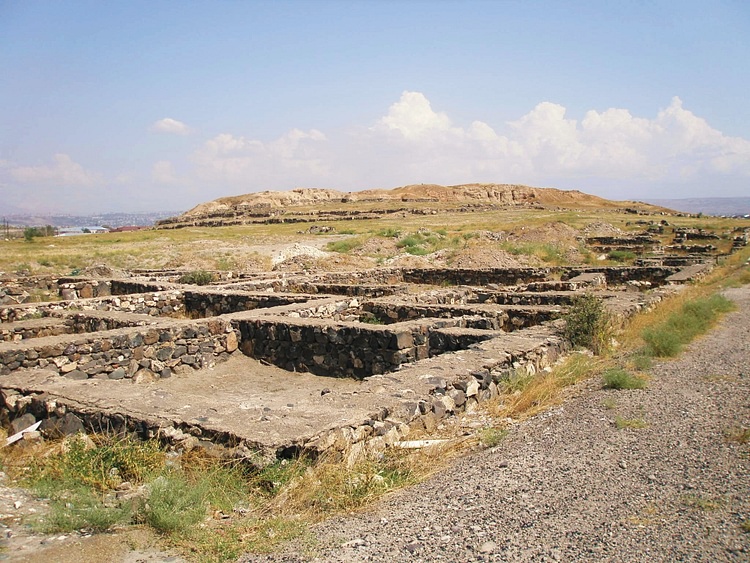
Teishebaini (aka Tesebaini, modern Karmir-Blur, near Yerevan, Armenia) was an important fortress city of the Urartu civilization and excavations at the site, largely undisturbed since its abandonment c. 590 BCE, have provided an invaluable insight into the daily life of the region during the Bronze and Iron age of the 9th to 6th century BCE. With huge walls, large storerooms, granaries, wine and beer vats, along with many specialised workshops packed with artefacts, Teishebaini was a thriving production centre and focal point of Urartian wealth and military power.
FOUNDATION & HISTORY
The Urartu civilization flourished between the 9th and early 6th century BCE in ancient Armenia, eastern Turkey, and northwestern Iran. The fortress city of Teishebaini, located on the Ararat Plain, was founded by king Rusa II (r. c. 685-645 BCE) and was named after Teisheba, the Urartian god of storms and thunder. Today the site is called Karmir-Blur, and it is located near the current capital of Armenia, Yerevan.
The city, a regional capital and seat of a viceroy, primarily functioned as an important fortress which helped maintain the rule of the Urartian kings over their empire. Inscriptions attest to the frequent visits by the king and the religious sacrifices that then had to be made in his honour. Artefacts of varying dates and carrying dedicatory inscriptions naming different kings suggest that such precious goods had been transferred from other Urartian sites once Teishebaini had been completed. The sheer volume of the site’s food storage capacity, much larger than needed for its own residents, indicates that Teishebaini was also an important administrative and economic centre in the region.
TEISHEBAINI COVERED AN AREA OF 400,000 SQUARE METRES (100 ACRES), WITH THE ROYAL PALACE ALONE BOASTING 120 ROOMS.
Finds of three-pronged arrowheads, typical of Scythian archers, found at the destroyed site of Teishebaini are suggestive. The destruction of the city first by military attack and then by fire sometime between 594 and 590 BCE seems to have been unexpected, with granaries recently filled and weapons and precious belongings seemingly abandoned in a hurry. The territories the Urartu kingdom had once occupied were ultimately taken over by the Medes from c. 585 BCE onwards and then incorporated into the Achaemenian Empire by Cyrus the Great in the mid-6th century BCE. Some Urartian cities continued to be inhabited into later times but Teishebaini was definitively abandoned in the early 6th century BCE.

Urartu
ARCHAEOLOGICAL EXCAVATIONS
Discovery
Teishebaini was only rediscovered in 1939 CE when Russian and Armenian archaeologists successfully followed a trail of artefacts and inscriptions which pointed to a settlement on a large mound in the outskirts of Yerevan. Handily, for the purposes of identification, a bronze belt and a ringed bolt were both inscribed in cuneiform with, “Rusa Argishtihini, fortress of the city of Teishebaini”. With both of these objects being portable, and so possibly from another fortress site, confirmation would have to wait until a doorway and a section of wall were excavated with matching inscriptions. The mound did indeed contain the ruins of Teishebaini. Once found, archaeologists struggled to know exactly where to begin in their excavations, but chance was to provide a helping hand, as the chief archaeologist Boris Piotrovsky explains:
…work was brought to a standstill by heavy rain; and on the following morning the whole layout of the fortress was visible on the ground. The walls of adobe brick retained the water longer than the earth filling and showed up clearly as darker outlines on the ground. (136)
Architecture
The site was revealed to cover an area of 400,000 square metres (100 acres), with the royal palace alone boasting 120 rooms and an area of 40,000 square metres. There were workshops, storerooms, wine cellars, granaries, housing and courtyards. Remains of the lower courses and foundations of the fortress’ towers survive and are formed of very large basalt blocks. The towers were square and the walls buttressed at intervals. The walls were up to 3.5 metres (12 feet) thick in places and possibly up to 7 metres high. The wall facing the river had several square projections outwards, and the whole complex was built in a stepped arrangement over the various levels and contours of the natural citadel. Access to the interior of the fortress was provided by means of a ramp on the south-western side, a massive South Gate and a postern gate in the north-west corner (it was this gate which bore the brunt of the attack which destroyed the city).
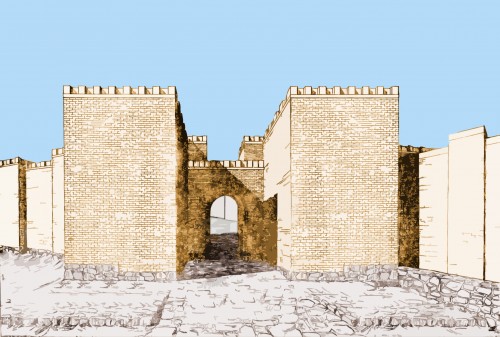
South Gate Reconstruction, Teishebaini
Some roofs of the buildings were made of wooden beams (e.g. pine, poplar or beech) and supported by wooden columns while others had barrel-vaulted roofs made from large adobe bricks. Doorways were made from thick wooden planks and fastened by means of a hinged bronze latch. The settlement was provided with fresh water via a canal running from the Ildaruni River and which went through a tunnel made into the basalt walls of the fortress.
There were private homes of various sizes and with a differing number of rooms, indicating they belonged to different social classes. Some buildings had two or three stories, and all were laid out in a regular plan suggesting that Teishebaini was purpose-built for a population who moved in upon completion.
The Storage Rooms
Once the walls were excavated and a general plan ascertained, excavations began to go deeper into the site. Piotrovsky here describes his impression when one storeroom first saw daylight again:
There was an atmosphere of desolation in the palace. There were wasps’s nests and skeletons of mice, and in one of the jars the skeletons of a mouse and a cat were found. The cat it seems chased the mouse into the jar and both found themselves trapped because of its depth. When the the dust of centuries had been removed, the warehouses gave the impression of having only recently been occupied. Jars full of corn, bowls, lamps of clay, iron knives - all tidily laid out. And no one had lived there for over 2500 years. (quoted in Chahin, 101)
Many of the large storage jars of Teishebaini were sunk into the floors of the storerooms. With each jar inscribed with its contents in cuneiform, they had an impressive combined capacity of 150,000 litres (40,000 gallons). These jars, often still containing organic remains, were used to store wheat, barley, millet, grapes, oil and sesame. Six wine stores had a capacity of 34,000 litres (9,000 gallons). Beer was brewed from barley which was fermented in large vats covered with straw and branches and then stored in elongated and round-bottomed jars.

Urartian Beer Pitchers
Yet another room was dedicated to the production of sesame oil and included a large tufa vat in which the seeds were first soaked before pressing. Finds of large churns with fitted wedges indicate that cheese and butter were also made.
One room at the fortress contained the neck and breast parts of 26 cattle. Another room was filled with the burned remains of young animals with their heads and extremities missing. Both of these rooms indicate the extent of animal sacrifice in the Urartu religion. Meanwhile, whole skeletons of cattle, horses, asses, and sheep found elsewhere show that animal husbandry was carried out on a significant scale at the site. One record lists precisely the manufacture of by-products such as wool and skins.
Workshops seem to have been dedicated to specific materials, one, for example, contained only stag horns and iron saws, another had loom weights, spindles, and a carbonised roll of cloth. Outside the citadel, there were workshops dedicated to pottery and metalwork. All of the stored and manufactured goods at the site were meticulously accounted for on inscribed clay tablets. In addition, many of the storerooms had their doors sealed with a knotted rope covered in clay and impressed with two official seals.

Urartu Decorated Quiver
Artefacts
As a testimony to Teishebaini and Urartu’s position as an important regional trading centre, many artefacts have been discovered at the site which are of foreign origin. These include Assyrian cylinder seals, a faience amulet from Egyptinscribed with hieroglyphics, a faience vessel typical of those from Rhodes, Scythian horse-bits, and gold jewellery from Asia Minor .
Regarding Urartian artefacts, a huge quantity of bronze and iron weapons have been excavated at Teishebaini, and they include swords, daggers, arrows, spears, helmets, shields, and quivers, many often incised with decorative scenes, especially of lions and bulls. There were statues of gods; a fish-man and a scorpion-man figurines; bronze cauldrons with ornate three-dimensional decorations around the rim; and large quantities of red polished pottery (especially jugs), with rarer examples of black pottery. One unusual form of Urartian pottery is the vessel made in the shape of a boot, complete with painted stitching and laces. Several examples have been excavated from Teishebaini, and they date to the 8th century BCE. Jewellery finds include bronze fibulas, sardonyx and carnelian beads, silvermedallions, and gold bracelets, earrings, and necklaces. There were 87 bronze cups neatly stacked in one room, many inscribed with a king’s name and an emblem of a fortified tower and a tree. Finally, there is a fine ivory statue and another figurine in bronze of Teisheba, the god who gave his name to this remarkable fortress site.
This article was made possible with generous support from the National Association for Armenian Studies and Researchand the Knights of Vartan Fund for Armenian Studies.
LICENSE
Article based on information obtained from these sources:with permission from the Website Ancient History Encyclopedia
Content is available under License Creative Commons: Attribution-NonCommercial-ShareAlike 3.0 Unported. CC-BY-NC-SA License